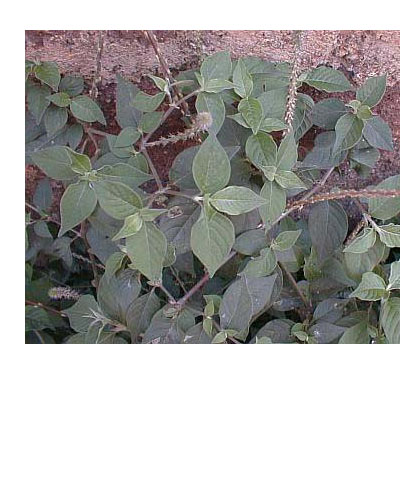Apamarg
Latin: Achyranthes Aspera
Therapeutic Action:
Remedies Astringent, alterative and antiperiodic, antibilious, diuretic, expectorant, purgative. Uses and Dosage For Renal Dropsies Make a decoction by adding 2 oz. of the plant to 1.5 pints of water. Boil for 20 - 30 minutes. Strain. This is a good diuretic. Useful for renal dropsies. Dose: one to two ounces of the mixture two or three times daily. For stomach ache and bowel complaints, piles, boils, skin eruptions etc. Use the leaf juice. For diarrhea and dysentery A decoction of powdered leaves with honey or sugar candy is useful in the early stages of diarrhea and dysentery. For Fevers Grind fresh leaves into a paste. Mix it with jaggery or black pepper and garlic. Form it into pills. This is a good antiperiodic especially in quartan fevers. For dropsies such as ascites, anasarca Mix the ashes from the roots of the herb with water and jaggery. This is said to cure dropsies such as ascites, anasarca etc. For Cough A pinch of the root-powder with a pinch of pepper powder and honey is a remedy for cough. For bites of poisonous insects, wasps, bees etc Rub the leaves into a paste with water. Apply this into the affected area. Grind the flowering spikes of the seeds into a paste with water. Apply externally to the affected region for bites of poisonous snakes and reptiles. For syphilitic sores Extract fresh juice from the leaves. Thicken the juice by evaporating by exposing to the sun. Mix it with a little opium. Apply to primary syphilitic sores. Miscellaneous Payasam or Kheer made of seeds in milk is a good remedy for brain diseases. An Infusion of the root is a mild astringent useful in bowel complaints. Seeds are used as an expectorant, or mixed with rice water for bleeding hemorrhoids. Seed soaked in buttermilk during the night and ground into an emulsion the next morning is a cure for biliousness. Apply Leaf juice applied to skin for overexposure to the sun. Leaves or seeds are used for poisonous animal bites. Traditional Medicinal Uses: According to Ayurveda, it is bitter, pungent, heating, laxative, stomachic, carminative and useful in treatment of vomiting, bronchitis, heart disease, piles, itching abdominal pains, ascites, dyspepsia, dysentery, blood diseases etc. Medicinal Uses Antispasmodic; Astringent; Diuretic; Odontalgic. One of the more important mdicinal herbs of Nepal, it is widely used in the treatment of a range of complaints. Ophthalmic[152]. The whole plant is used medicinally, but the roots are generally considered to be more effective[283]. They contain triterpenoid saponins[283]. The root is astringent, diuretic and antispasmodic[152, 178, 272]. It is used in the treatment of dropsy, rheumatism, stomach problems, cholera, skin diseases and rabies[152, 272]. The juice extracted from the root of this plant, mixed with the root of Urena lobata and the bark of Psidium guajava, is used in the treatment of diarrhoea and dysentery[272]. The plant is astringent, digestive, diuretic, laxative, purgative and stomachic[272]. The juice of the plant is used in the treatment of boils, diarrhoea, dysentery, haemorrhoids, rheumatic pains, itches and skin eruptions[272]. The ash from the burnt plant, often mixed with mustard oil and a pinch of salt, is used as a tooth powder for cleaning teeth[272]. It is believed to relieve pyorrhea and toothache[272]. The leaf is emetic and a decoction is used in the treatment of diarrhoea and dysentery[272]. A paste of the leaves is applied in the treatment of rabies, nervous disorders, hysteria, insect and snake bites[272].
References:
- Nadkarni, Vol I, P 21-22
- Paranjape. P 12-13
- Nadkarni, Vol I, P 12-13
Used in:
- Cufsil Syrup
- Kufrex Syrup
- Sans - Stone Syrup / Tablet

Copyright 2013 Unexo Laboratories Pvt. Ltd. All Rights Reserved. Designed & Developed By: Credence Technologies


